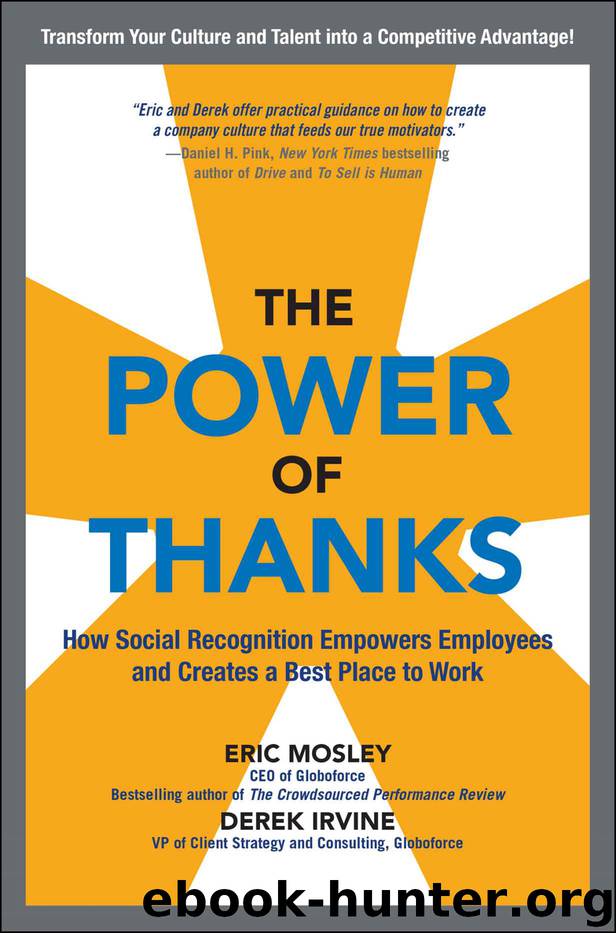The Power of Thanks: How Social Recognition Empowers Employees and Creates a Best Place to Work: How Social Recognition Empowers Employees and Creates a Best Place to Work DIGITAL AUDIO by Eric Mosley & Derek Irvine

Author:Eric Mosley & Derek Irvine
Language: eng
Format: mobi
Publisher: McGraw-Hill Education
Published: 2014-12-11T14:00:00+00:00
24/7 Connectedness
“Working from home” once meant taking home a briefcase full of papers on the weekend. Now it means plugging into a cloud-based set of secure company applications and information with your tablet or smartphone. It means greater flexibility and productivity by removing barriers of time and space. Jason Averbook, author of HR from Now to Next, calls this enabling people to work, the way they work, outside of work.
It also means new questions about what constitutes a workday. If I save two hours of commuting time because the company provides technology for me to work remotely, does that time belong to the company or to me? If the company asks me to review a report at 10:00 a.m. on a Saturday, can I do my personal e-mail on Monday? Is my habit of 24/7 connectedness to my Twitter feeds beneficial to the company because half of the tweets I read are relevant to work? The answers to these questions and dozens more are sometimes found in formal company policies and sometimes as informal standards—and often just as adapted behaviors (as in, “Honey, please don’t read your work e-mails at the dinner table.”).
This 24/7 connectedness leads to an alternative view of life-work balance called life-work blending, in which both realms recognize the other’s importance and need to cooperate when it comes to time and focus. As management consultant and author Ron Ashkenas wrote in Forbes, we need to become flexible in how we accomplish both our work goals and our personal goals.11 Both need to recognize the other’s importance.
Recognition’s emphasis on human emotions, motivations, and personal connection in a business context fits philosophically with this view.
In recognition, the time shift to 24/7 connectedness is similar to the location shift of mobile computing. It improves program adoption by removing barriers to use. There may not be time in a day to recognize a colleague, but later, recalling her good job, I should be able to easily nominate her for an award. And the benefit is twofold, because she might first learn of that award outside of office hours. If 24/7 connectedness means life-work blending, shouldn’t the benefits and good news reach employees just as easily as demands?
Download
This site does not store any files on its server. We only index and link to content provided by other sites. Please contact the content providers to delete copyright contents if any and email us, we'll remove relevant links or contents immediately.
The Brazilian Economy since the Great Financial Crisis of 20072008 by Philip Arestis Carolina Troncoso Baltar & Daniela Magalhães Prates(116951)
International Integration of the Brazilian Economy by Elias C. Grivoyannis(86771)
The Art of Coaching by Elena Aguilar(52844)
Flexible Working by Dale Gemma;(23232)
How to Stop Living Paycheck to Paycheck by Avery Breyer(19604)
The Acquirer's Multiple: How the Billionaire Contrarians of Deep Value Beat the Market by Tobias Carlisle(12190)
Thinking, Fast and Slow by Kahneman Daniel(11988)
The Radium Girls by Kate Moore(11877)
The Art of Thinking Clearly by Rolf Dobelli(10150)
Hit Refresh by Satya Nadella(9001)
The Compound Effect by Darren Hardy(8742)
Tools of Titans by Timothy Ferriss(8163)
Atomic Habits: Tiny Changes, Remarkable Results by James Clear(8130)
Turbulence by E. J. Noyes(7903)
Change Your Questions, Change Your Life by Marilee Adams(7575)
A Court of Wings and Ruin by Sarah J. Maas(7569)
Nudge - Improving Decisions about Health, Wealth, and Happiness by Thaler Sunstein(7472)
How to Be a Bawse: A Guide to Conquering Life by Lilly Singh(7349)
Win Bigly by Scott Adams(7041)
